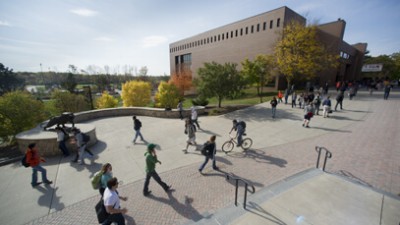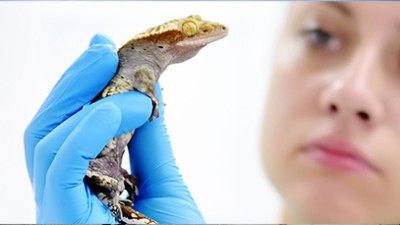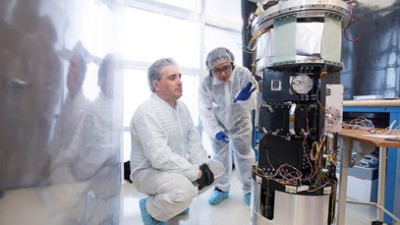News
-
March 21, 2022
![two students working in a room surrounded by orange windows.]()
RIT Master Plan cuts tuition in half for eligible alumni
RIT is extending a special graduate tuition scholarship program to recent alumni as the COVID-19 pandemic enters its third year. The program helps alumni who graduated during the pandemic enhance their skill set for the new economy through master’s degrees that build upon collaboration, analytical thinking, complex problem solving, and flexibility.
-
March 18, 2022
![group of 13 students poses outdoors next to sign for Common Ground Relief Wetlands.]()
Students help communities during spring break
RIT students planted trees in Louisiana, revitalized farms and greenhouses in West Virginia, and repaired hiking trails in Georgia and Virginia as projects during this year’s Alternative Break.
-
March 17, 2022
![white clover plants.]()
RIT scientists part of massive study on clover showing urbanization drives adaptive evolution
RIT contributed to a massive study on a tiny roadside weed that shows urbanization is leading to adaptive evolution at a global scale. As part of the Global Urban Evolution Project (GLUE) project, scientists from 160 cities across six continents collected more than 110,000 samples of white clover plants in urban, suburban, and rural areas to study urbanization’s effects on the plants.
-
March 13, 2022
![three panelists sitting at high top tables on a stage.]()
Watch, Read: Bringing Space Superiority Into the Light
Air Force Magazine talks to Erich Hernandez-Baquero ’00 Ph.D. (imaging science), executive director of Raytheon Intelligence and Space, about “space superiority.”
-
March 8, 2022
![Three rings of ejected gas sail away from an aging star.]()
A new image captures enormous gas rings encircling an aging red star
ScienceNews talks to Joel Kastner, professor in the Chester F. Carlson Center for Imaging Science, about mass loss in stars.
-
February 26, 2022
![Hubble Space Telescope's view of the COSMOS survey area.]()
Major James Webb Space Telescope project will map half a million early galaxies
Space.com features Jeyhan Kartaltepe, assistant professor in the School of Physics and Astronomy.
-
February 25, 2022
![Richard O’Shaughnessy, associate professor in RIT’s College of Science.]()
RIT astrophysicist awarded research leave to study gravitational waves as a Simons Fellow
Richard O’Shaughnessy, an associate professor in RIT’s School of Mathematical Sciences, was awarded a prestigious fellowship to spend the next year preparing for an “onslaught” of gravitational wave discoveries. He is one of 10 faculty worldwide named 2022 Simons Fellows in Theoretical Physics and is the first RIT faculty member to receive the award.
-
February 23, 2022
![side-by-side images of a mountain range, the left showing the landscape and the right showing a temperature map.]()
RIT’s remote sensing experts help scientists keep an eye on the Earth
Scientists from RIT’s Chester F. Carlson Center for Imaging Science recently helped successfully bring the new Landsat 9 satellite online and are partnering with a startup on a bold new initiative to help scientists in government and the private sector monitor changes in the Earth’s surface temperature.
-
February 20, 2022
![Professor Christy Tyler stands to the right of a projection screen in front of a class of students.]()
Sustainability seminar discusses new research in wetland restoration
Campus Times interviews Professor Christy Tyler about how to rethink wetland ecosystem restoration.
-
February 15, 2022
![two students hugging in front of school lockers.]()
Rochester Prep High School students share their capstone experience
One highlight of the RIT-Rochester Prep High School Partnership is the annual capstone showcase that spotlights student-professor collaborations. Their diverse projects in photojournalism, antibiotic resistance, 3D printing and fabrication, and chemical engineering gave the students experience on a college campus and the confidence of completing undergraduate-level material.
-
February 14, 2022
![photo illustration of knee pain.]()
RIT scientists develop biophysical model to help better diagnose and treat osteoarthritis
Scientists from RIT and Cornell University have teamed up to explore cartilage tissue’s unique properties with the hopes of improving osteoarthritis diagnosis and treatment. The team published a new paper in Science Advances outlining their findings.
-
February 11, 2022
![three student researchers comparing plates of bacteria.]()
RIT professor working to tackle antibiotic resistance
WHEC-TV talks to André Hudson, professor and head of the Thomas H. Gosnell School of Life Sciences, about his antibiotics research.
















